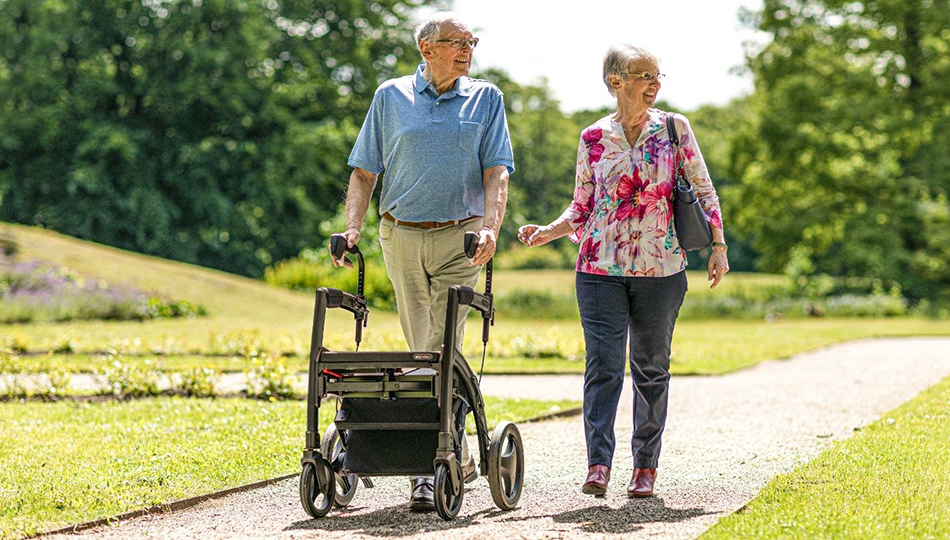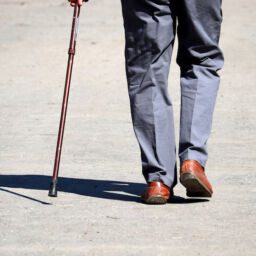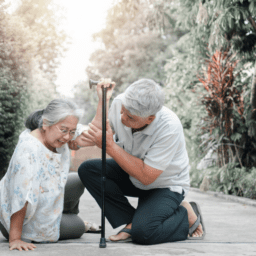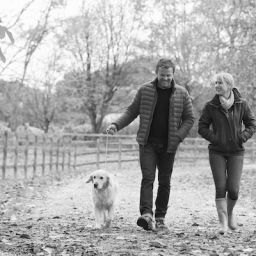Can you guess what people write to us about the most? It’s not their tremor. It’s not bradykinesia. It’s not a loss of smell or dyskinesia or even exercise. It’s about their challenges with freezing of gait (FOG), balance, and falling.
They tell us that these get in the way of living well because their fear of falling or being stared at stops them from traveling, going out in public, being in crowds, and doing many activities of daily living. So, let’s dive into each concern and what you can do about them, starting at the top of the waterfall with postural instability.
postural instability
When you think of a person with Parkinson’s (or maybe even yourself), you may picture someone with a stooped posture, shuffling along as they use a cane. This is an example of postural instability. However, postural instability is more than just stooped posture. The body’s loss of muscle mass, caused by aging and amplified by Parkinson’s, causes balance issues that lead to postural instability, leading to other issues such as gait dysfunction.
gait dysfunction
Gait dysfunction, which may include freezing or the inability to walk with even and fluid steps, worsens as your balance becomes less steady. You may experience gait dysfunction most when trying to do more than one thing at a time, called dual tasking. For example, when grocery shopping, you’re not just paying attention to where items are and what you need to add to your cart; you’re also working to manage your motor function.
Taken together, gait-related issues and postural instability make people with Parkinson’s especially susceptible to falling. And if the fall is a bad one, it can cause hip and other bone fractures, decrease mobility, make it difficult or impossible to exercise, inhibit sleep, and create anxiety and depression, all of which severely decrease quality of life.
So, how can you combat gait dysfunction and postural instability to live better with Parkinson’s?
Here are three actions you can take to improve these symptoms and minimize your risk of falling.
#1 Exercise & Work with a Physical Therapist
Exercise is the best thing you can do if you have Parkinson’s. Aside from being good for your heart, mood, and brain, it’s also necessary for building muscle, which plays a significant role if you do fall. Together with help from a physical therapist, you can learn exercises that help with gait-related issues and postural instability, such as cycling, Nordic walking, using metronomes and music while moving, and strength training. Physical therapists are trained to help you work on managing your symptoms and improve your quality of life. We have quite a few resources on finding the right physical therapist for your needs, but we recommend starting here.
#2 – Take (or Adjust) Your Medication
The first line of treatment for helping with motor symptoms is often to start or increase dopaminergic medications that aim to keep you in an ON state for longer. These medications can reduce your tremor, bradykinesia, or other motor symptoms that make it difficult for you to balance and move well. However, evidence suggests that there’s a cognitive component of freezing that medication does not address effectively. So, as usual, medication is just one part of the equation.
#3 – Consider Using a Mobility Aid
The main benefit of mobility aids is that they help reduce the possibility of falling. Fortunately, they are becoming increasingly popular and available, too. For example, poles are an effective way to increase your support base because they can improve your balance and make it less likely that you will trip or freeze. Laser canes, which give an additional constant visual stimulus to focus on, work great for many people. Some companies like NexStride make devices you can put on a crutch, cane, or walker that deliver cues to reduce freezing.
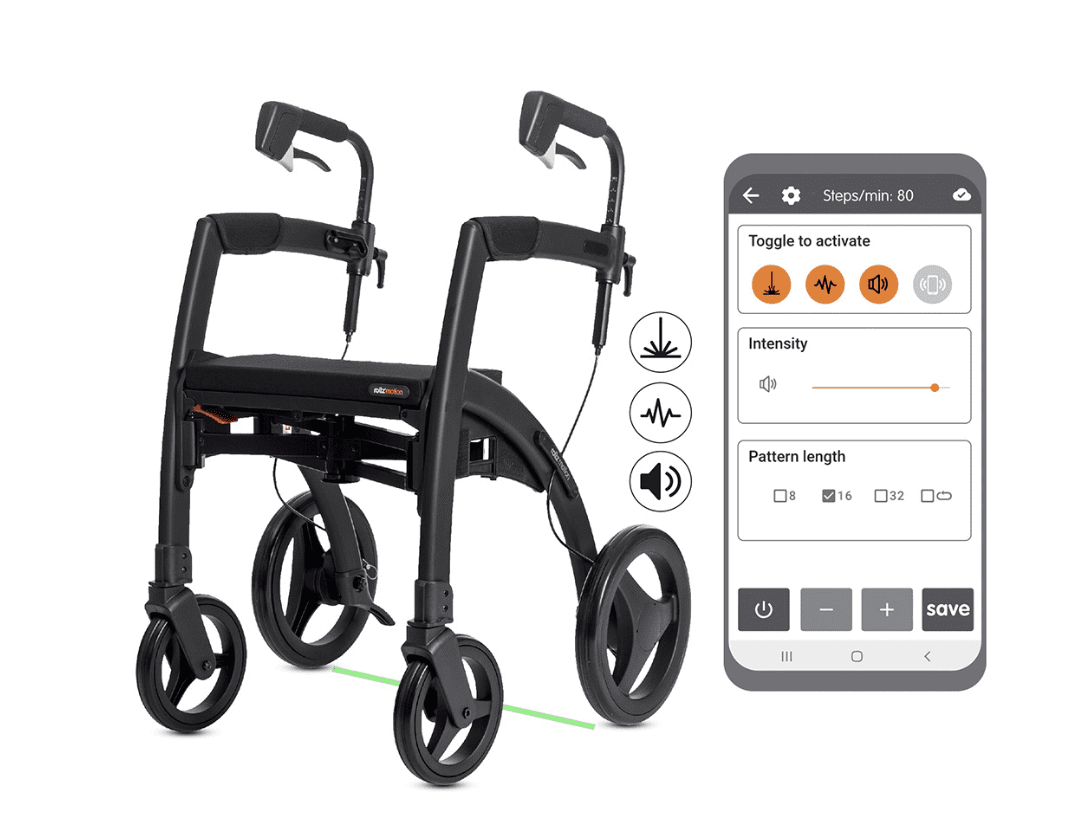 Additionally, the Rollz motion rhythm walker is ideal for people with Parkinson’s who need extra assistance, so that balance issues don’t turn into falling issues. This rollator uses multiple cues depending on your situation (laser, sound, vibration) and can be easily managed with the push of a button. You can also determine speed, intensity, and duration and set it up on an app on your phone if you want to.
Additionally, the Rollz motion rhythm walker is ideal for people with Parkinson’s who need extra assistance, so that balance issues don’t turn into falling issues. This rollator uses multiple cues depending on your situation (laser, sound, vibration) and can be easily managed with the push of a button. You can also determine speed, intensity, and duration and set it up on an app on your phone if you want to.
Here’s an example of a person with Parkinson’s using the rollator to move better. And here’s another one.
That said, walkers and rollators are not the best fit for everyone, so always consult your doctor before you purchase or use any mobility aid or walker.
As one of our partners that believes deeply in our cause to help people live well today with Parkinson’s, Rollz wanted to offer a 10% discount to anyone who purchases one of their Parkinson’s rollators. All you have to do is use code DPF10 at checkout here. As part of their give-back campaign, they will provide a 10% charitable donation to the Davis Phinney Foundation for every product sold under this program.
If you’re curious about insurance, currently, there’s no direct way to get your insurance to cover the Rollz rollator; however, there are several avenues to explore depending on your medical insurance. First, because everyone’s medical benefits are so different, the best thing to do is reach out to your benefits administrator to see if they will cover this. Sometimes, your doctor can prescribe a device to get your insurance to cover it. If you need more information about the rollator to provide to your insurance provider, contact Rollz at 929-999-4178 or [email protected].
Is Freezing or Falling a Big Issue for You?
Be sure to join us for our next Living with Parkinson’s Meetup on Thursday, November 17, at 1 pm MST, when special guest and physical therapist Maria Allen will join us to discuss FOG, falls, and what you can do to prevent them. Register for free here.
Thank You to Our Sponsor
While the generous support of our sponsors makes our educational programs possible, their donations do not influence Davis Phinney Foundation content, perspective, or speaker selection.


